The Economics of Animal Health: A 25-Year Bibliometric Analysis
Abstract
Simple Summary
Abstract
1. Introduction
2. Materials & Methods
2.1. Inclusion and Exclusion Criteria
2.2. Validation
2.3. Descriptive Bibliometric Analysis
2.4. Network Analysis and Visualization
3. Results
3.1. Descriptive Bibliometric Analysis
3.1.1. Annual Growth in Publication Numbers (2000–2024)
3.1.2. Geographic Distribution of Articles
3.1.3. Author Contributions and Influence
3.1.4. Keyword Analysis
3.1.5. Journal and Publisher Analysis
3.1.6. Citation Impact and Distribution
3.1.7. Institutional Distribution
3.2. Network Analysis and Visualization
3.2.1. Coauthorship Network: Authors
3.2.2. Coauthorship Network: Organizations
3.2.3. Coauthorship Network: Countries
3.2.4. Keyword Co-Occurrence: Research Themes
3.2.5. Keyword Co-Occurrence and Temporal Evolution
3.2.6. Citation Network: Journals
3.2.7. Citation Network: Organizations
3.2.8. Citation Network: Countries
4. Discussion
5. Conclusions
Supplementary Materials
Author Contributions
Funding
Institutional Review Board Statement
Informed Consent Statement
Data Availability Statement
Conflicts of Interest
References
- Rushton, J. The Economics of Animal Health and Production; CABI Publishing: Wallingford, UK, 2009. [Google Scholar]
- McInerney, J.P. Old economics for new problems—Livestock disease: Presidential address. J. Agric. Econ. 1996, 47, 295–314. [Google Scholar] [CrossRef]
- Knight-Jones, T.J.D.; Rushton, J. The economic impacts of foot and mouth disease—What are they, how big are they and where do they occur? Prev. Vet. Med. 2013, 112, 161–173. [Google Scholar] [CrossRef]
- Perry, B.D.; Randolph, T.F. Improving the assessment of the economic impact of parasitic diseases and of their control in production animals. Vet. Parasitol. 1999, 84, 145–168. [Google Scholar] [CrossRef]
- Smith, K.M.; Machalaba, C.C.; Seifman, R.; Feferholtz, Y.; Karesh, W.B. Infectious disease and economics: The case for considering multi-sectoral impacts. One Health 2019, 7, 100080. [Google Scholar] [CrossRef]
- Zinsstag, J.; Schelling, E.; Waltner-Toews, D.; Tanner, M. From “one medicine” to “one health” and systemic approaches to health and well-being. Prev. Vet. Med. 2011, 101, 148–156. [Google Scholar] [CrossRef]
- Van Eck, N.J.; Waltman, L. Software survey: VOSviewer, a computer program for bibliometric mapping. Scientometrics 2010, 84, 523–538. [Google Scholar] [CrossRef]
- Waltman, L.; van Eck, N.J.; Noyons, E.C. A unified approach to mapping and clustering of bibliometric networks. J. Informetr. 2010, 4, 629–635. [Google Scholar] [CrossRef]
- Rushton, J.; Thornton, P.K.; Otte, M.J. Methods of economic impact assessment. Rev. Sci. Tech. Off. Int. Des Epizoot. 1999, 18, 315–342. [Google Scholar] [CrossRef] [PubMed]
- McInerney, J.P.; Howe, K.S.; Schepers, J.A. A framework for the economic analysis of disease in farm livestock. Prev. Vet. Med. 1992, 13, 137–154. [Google Scholar] [CrossRef]
- Seegers, H.; Fourichon, C.; Beaudeau, F. Production effects related to mastitis and mastitis economics in dairy cattle herds. Vet. Res. 2003, 34, 475–491. [Google Scholar] [CrossRef]
- Halasa, T.; Huijps, K.; Østerås, O.; Hogeveen, H. Economic effects of bovine mastitis and mastitis management: A review. Vet. Q. 2007, 29, 18–31. [Google Scholar] [CrossRef] [PubMed]
- Huijps, K.; Lam, T.J.; Hogeveen, H. Costs of mastitis: Facts and perception. J. Dairy Res. 2008, 75, 113–120. [Google Scholar] [CrossRef]
- Dijkhuizen, A.A.; Morris, R.S. Animal Health Economics: Principle and Applications; University of Sidney: Sidney, Australia, 1997. [Google Scholar]
- Bennett, R. The ‘direct costs’ of livestock disease: The development of a system of models for the analysis of 30 endemic livestock diseases in Great Britain. J. Agric. Econ. 2003, 54, 55–71. [Google Scholar] [CrossRef]
- Perez, A.M. Past, present, and future of veterinary epidemiology and economics: One health, many challenges, no silver bullets. Front. Vet. Sci. 2015, 2, 60. [Google Scholar] [CrossRef]
- Camilon, M.D.F.; Callo, E.C.; Panoy, J.F.D. Factors associated with research and productivity among faculty of higher education institutions: Input to enhancing research culture. IJMABER 2024, 5, 4497–4509. [Google Scholar] [CrossRef]
- Lane, J.K.; Kelly, T.; Bird, B.; Chenais, E.; Roug, A.; Vidal, G.; Gallardo, R.; Zhou, H.; VanHoy, G.; Smith, W. A One Health Approach to Reducing Livestock Disease Prevalence in Developing Countries: Advances, Challenges, and Prospects. Annu. Rev. Anim. Biosci. 2024, 13, 277–302. [Google Scholar] [CrossRef]
- Tesema, B. Cattle genetic improvement strategies for sustainable development in tropics: Review. Bull. UASVM Anim. Sci. Biotechnol. 2023, 80, 22–35. [Google Scholar] [CrossRef]
- O’Connor, A.H.; Shalloo, L.; Bokkers, E.A.M.; de Boer, I.J.M.; Hogeveen, H.; Sayers, R.; Byrne, N.; Ruelle, E. Modeling the economic impacts of mobility scores in dairy cows under Irish spring pasture-based management. J. Dairy Sci. 2023, 106, 1218–1232. [Google Scholar] [CrossRef]
- Kulkarni, P.S.; Haijema, R.; Hogeveen, H.; Steeneveld, W.; Mourits, M.C. Economic impacts of constrained replacement heifer supply in dairy herds. Agric. Syst. 2024, 217, 103943. [Google Scholar] [CrossRef]
- Freshwater, D.; Sherwood, G.; Drury, V. International research collaboration: Issues, benefits and challenges of the global network. J. Res. Nurs. 2006, 11, 295–303. [Google Scholar] [CrossRef]
- Duarte, A.; Walker, S.; Metry, A.; Wong, R.; Panovska-Griffiths, J.; Sculpher, M. Jointly modelling economics and epidemiology to support public policy decisions for the COVID-19 response: A review of UK studies. Pharmacoeconomics 2021, 39, 879–887. [Google Scholar] [CrossRef]
- González-Alcaide, G.; Aleixandre-Benavent, R.; Navarro-Molina, C.; Valderrama-Zurián, J.C. Coauthorship networks and institutional collaboration patterns in reproductive biology. Fertil. Steril. 2008, 90, 941–956. [Google Scholar] [CrossRef]
- Wuchty, S.; Jones, B.F.; Uzzi, B. The increasing dominance of teams in production of scientific knowledge. Science 2007, 316, 1036–1039. [Google Scholar] [CrossRef]
- Kossaibati, M.A.; Esslemont, R.J. The costs of production diseases in dairy herds in England. Vet. J. 1997, 154, 41–51. [Google Scholar] [CrossRef]
- Mungube, E.O.; Tenhagen, B.A.; Regassa, F.; Kyule, M.N.; Shiferaw, Y.; Kassa, T.; Baumann, M.P.O. Reduced milk production in udder quarters with subclinical mastitis and associated economic losses in crossbred dairy cows in Ethiopia. Trop. Anim. Health Prod. 2005, 37, 503–512. [Google Scholar] [CrossRef]
- Halasa, T.; Nielen, M.; De Roos, A.P.W.; Van Hoorne, R.; de Jong, G.; Lam, T.J.G.M.; van Werven, T.; Hogeveen, H. Production loss due to new subclinical mastitis in Dutch dairy cows estimated with a test-day model. J. Dairy Sci. 2009, 92, 599–606. [Google Scholar] [CrossRef]
- Li, S.; Zhang, M.; Hou, L.; Gong, B.; Chen, K. A framework for cost-effectiveness analysis of greenhouse gas mitigation measures in dairy industry with an application to dairy farms in China. J. Env. Manag. 2024, 370, 122521. [Google Scholar] [CrossRef] [PubMed]
- Siachos, N.; Neary, J.M.; Smith, R.F.; Oikonomou, G. Automated dairy cattle lameness detection utilizing the power of artificial intelligence; current status quo and future research opportunities. Vet. J. 2024, 304, 106091. [Google Scholar] [CrossRef] [PubMed]
- Shi, R.; Van der Linden, A.; Oosting, S.; Wang, Y.; Ducro, B. Derivation of economic values for breeding objective traits of Chinese Holstein dairy cows using a bio-economic model. J. Anim. Breed. Genet. 2025, 142, 513–527. [Google Scholar] [CrossRef] [PubMed]
- Yang, X.; Liu, B.; Zhang, L.; Wang, X.; Xie, J.; Liang, J. Spatial Distribution and Dietary Risk Assessment of Aflatoxins in Raw Milk and Dairy Feedstuff Samples from Different Climate Zones in China. Toxins 2025, 17, 41. [Google Scholar] [CrossRef]
- Naseem, R.; Abbasi, A.M.; Ajab, H.; Khan, L.; Faridullah, F.; Yaqub, A. Quantification of toxic metals contamination and health risk assessment in processed and raw dairy products in Abbottabad city. J. Hazard. Mater. Adv. 2025, 17, 100537. [Google Scholar] [CrossRef]
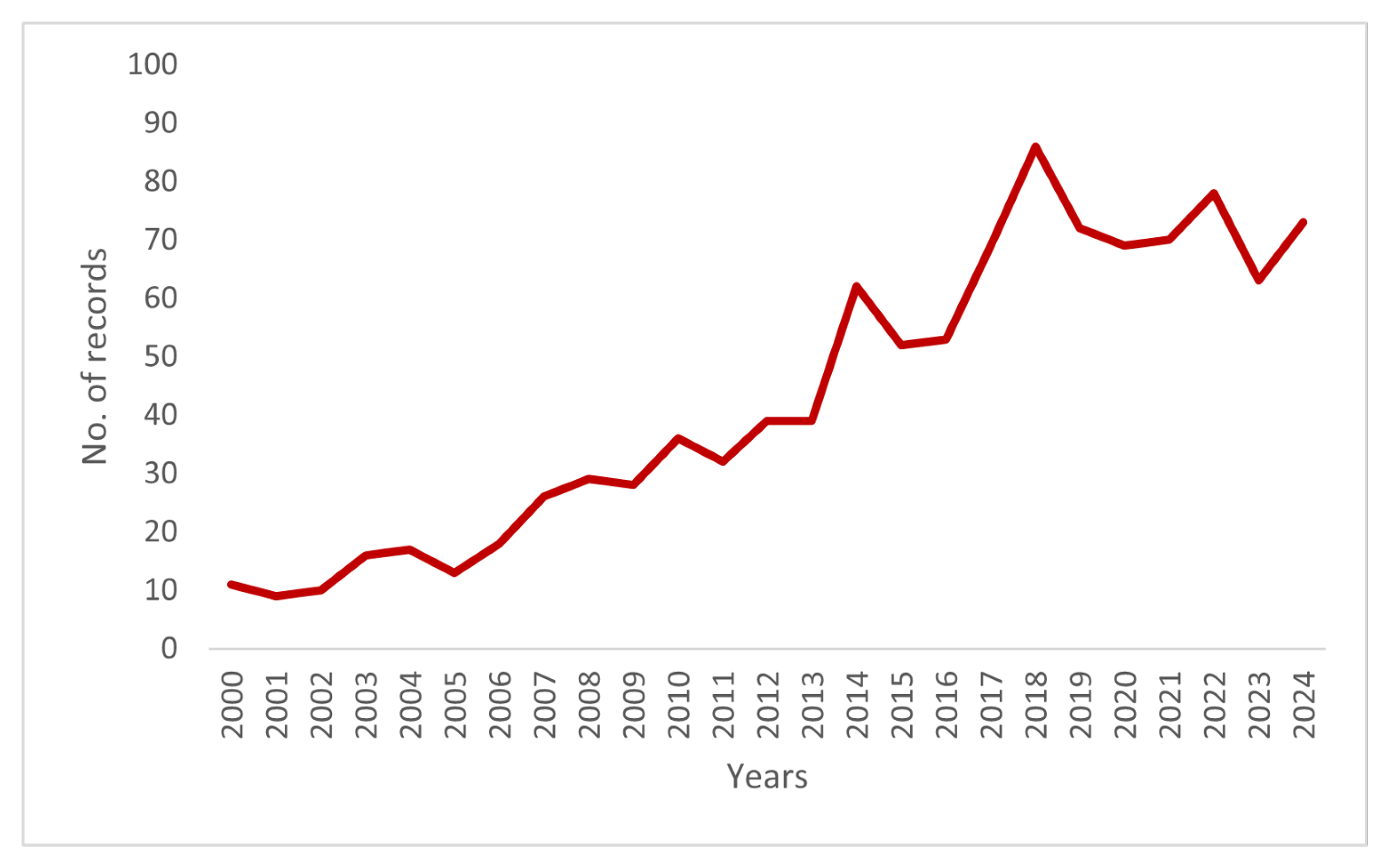
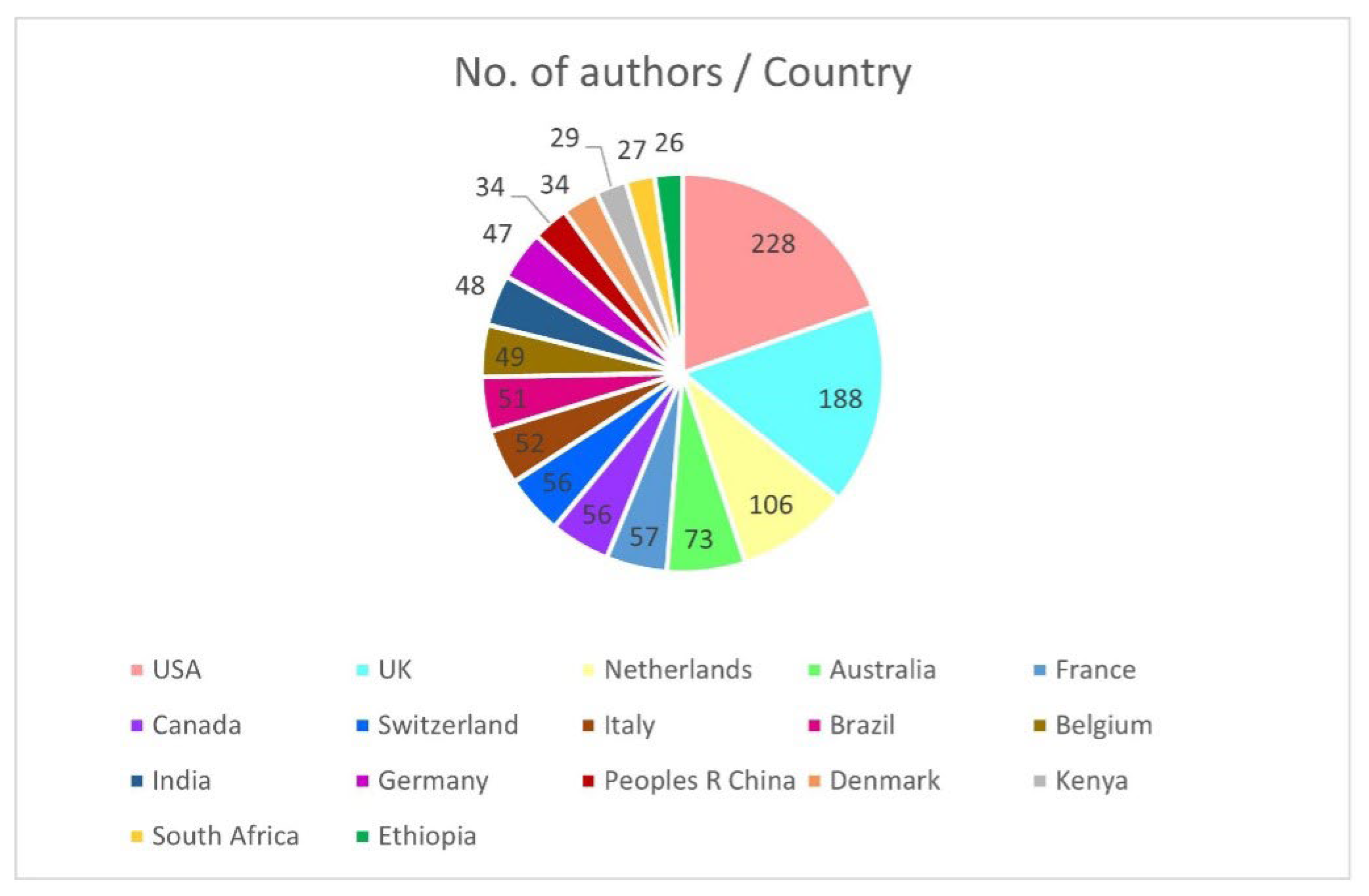

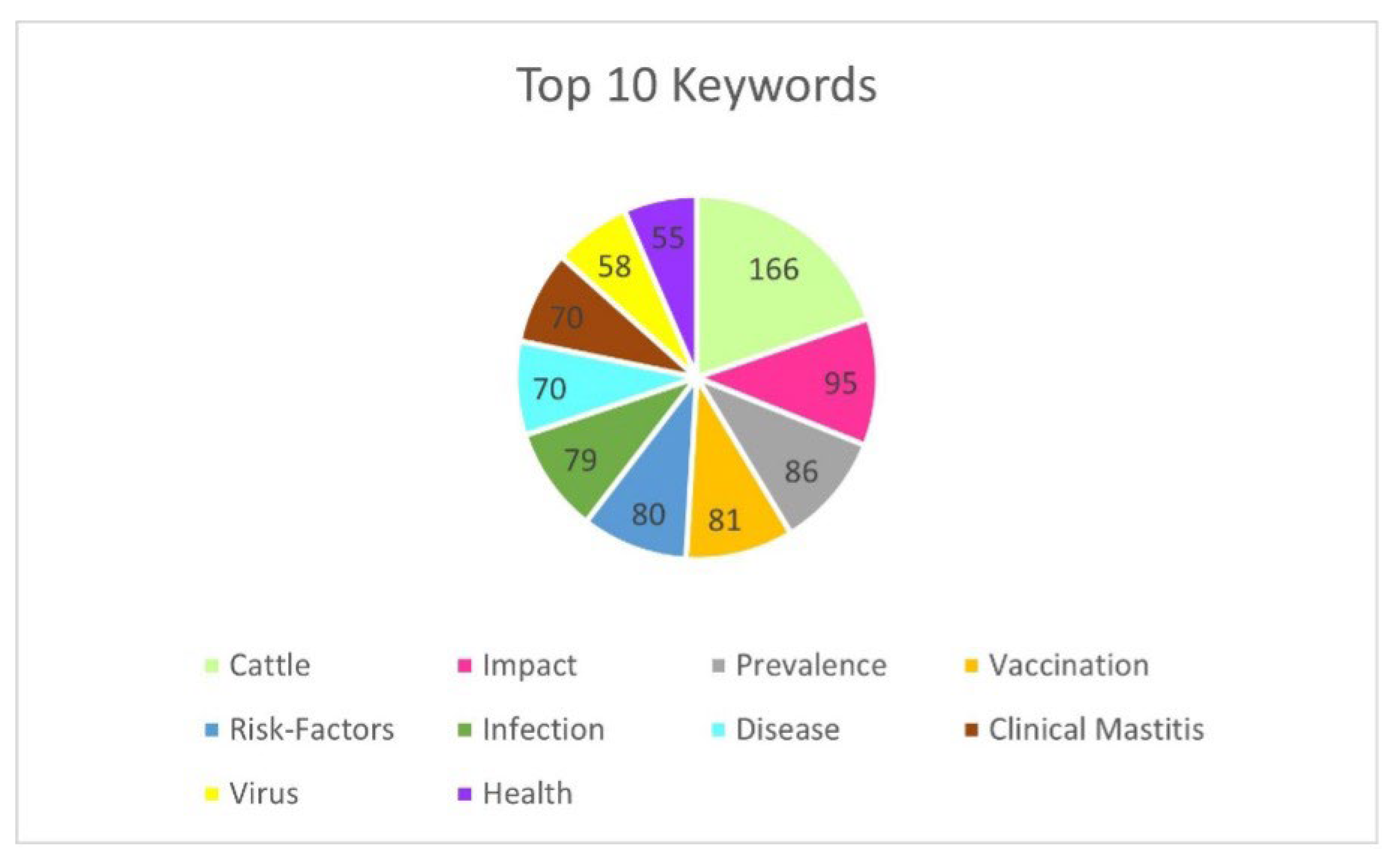
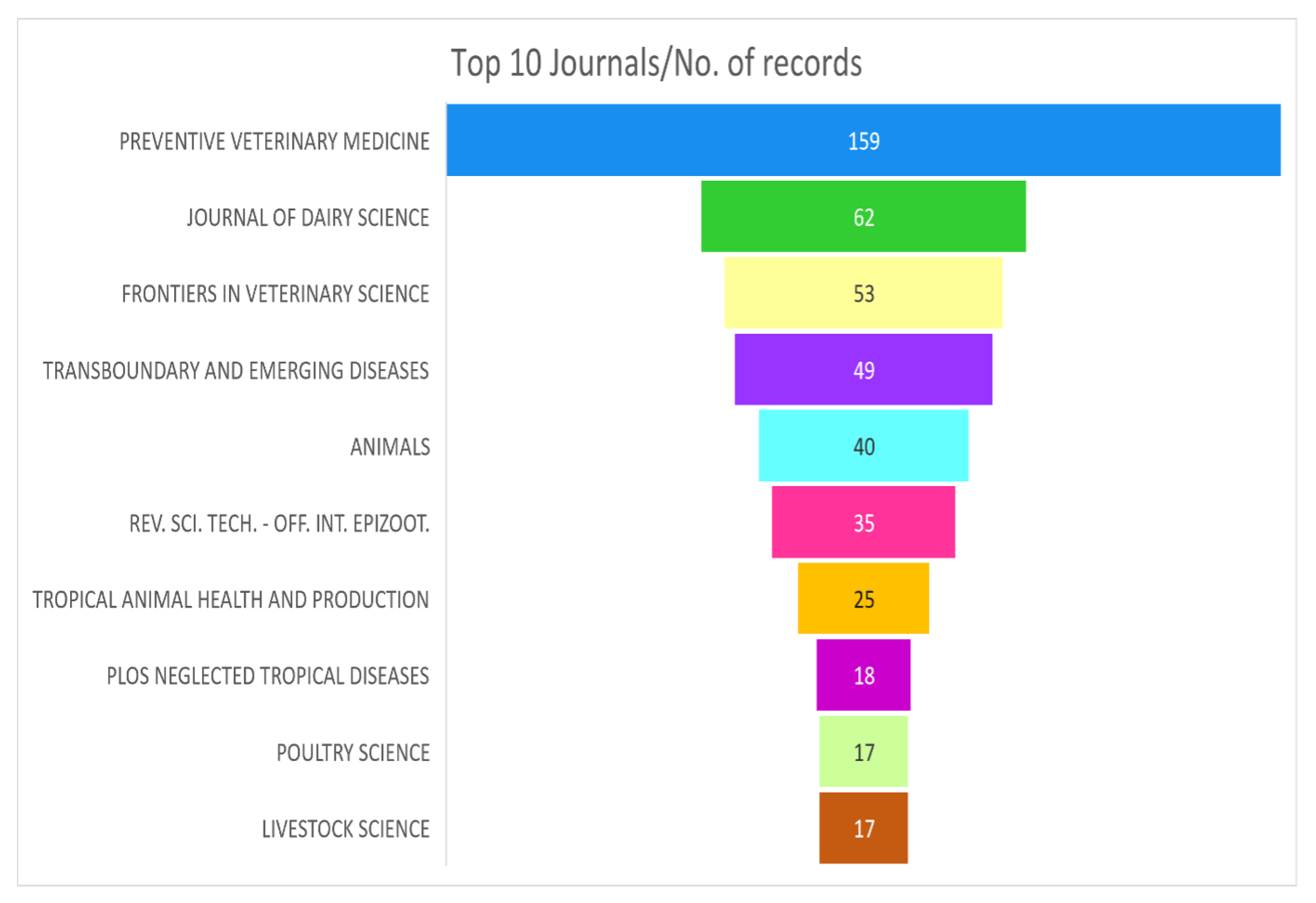
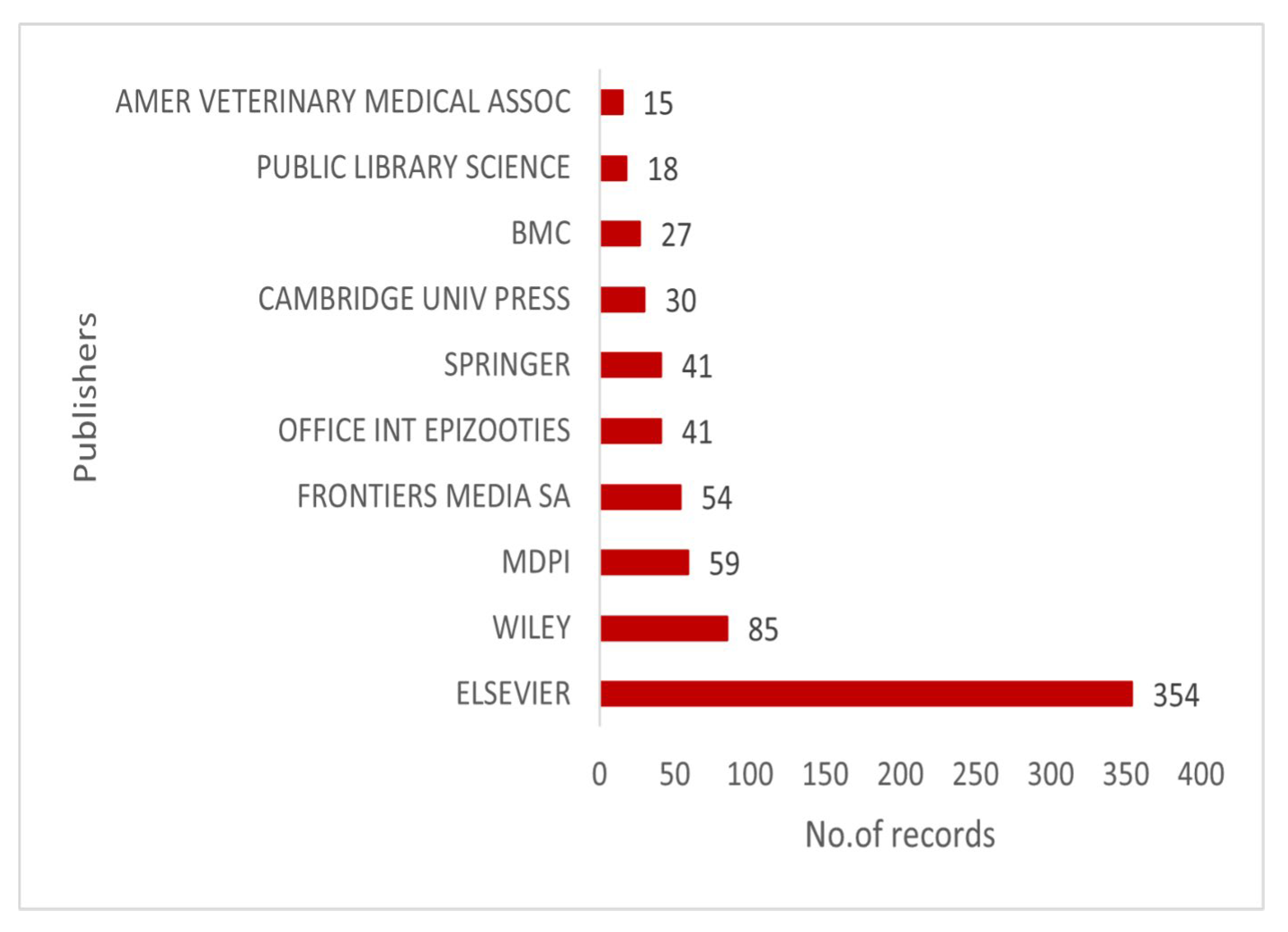
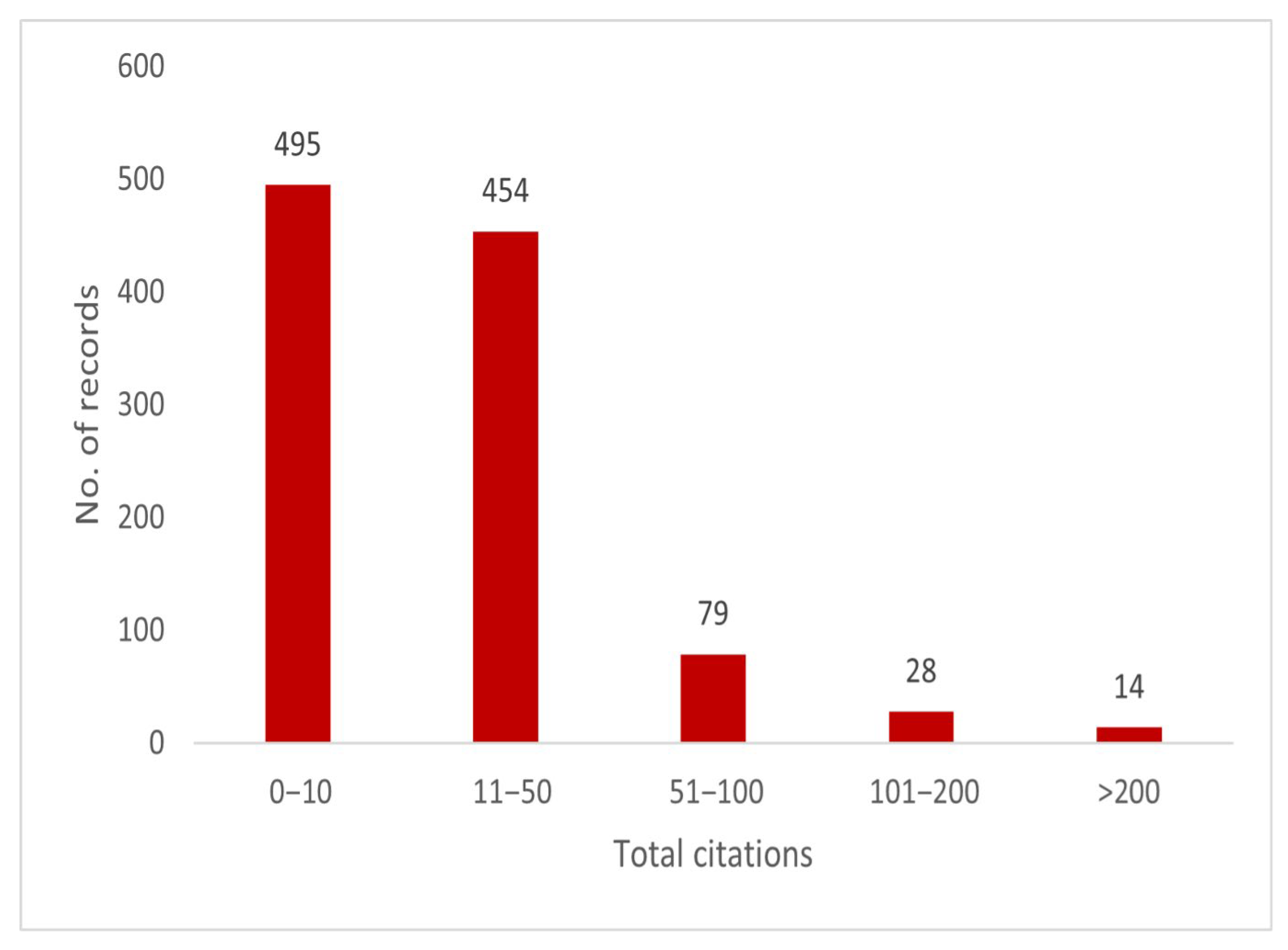
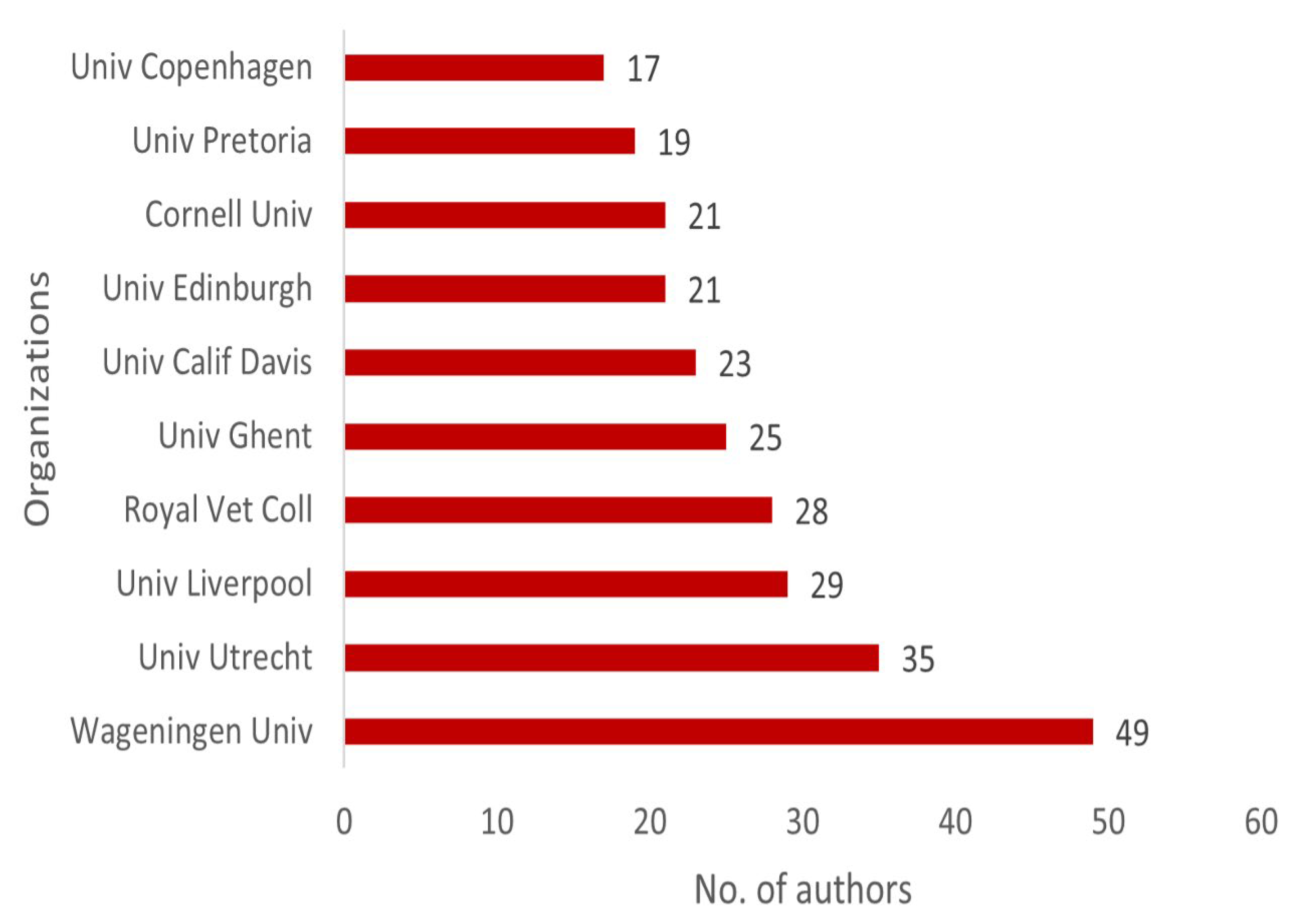
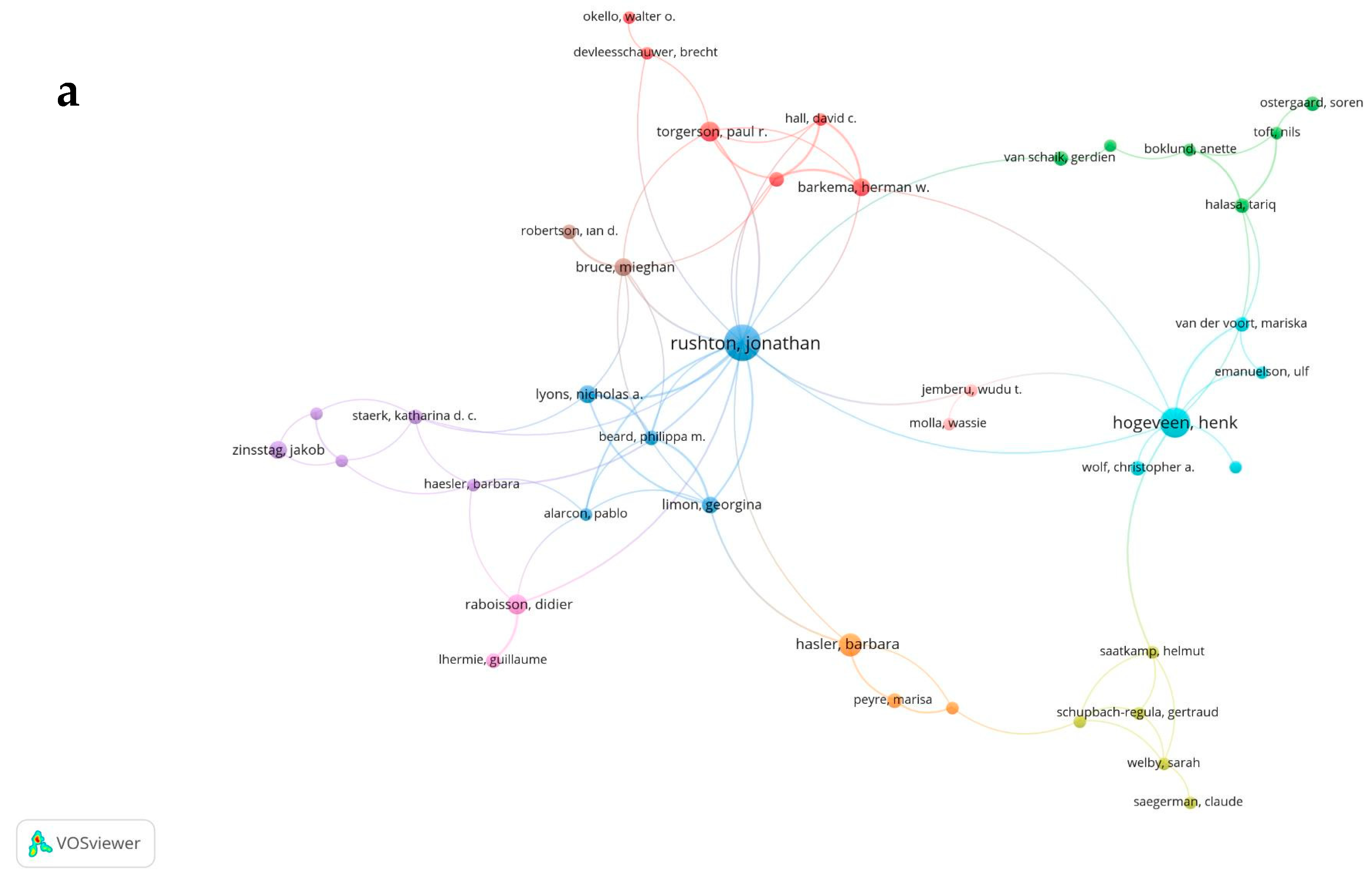
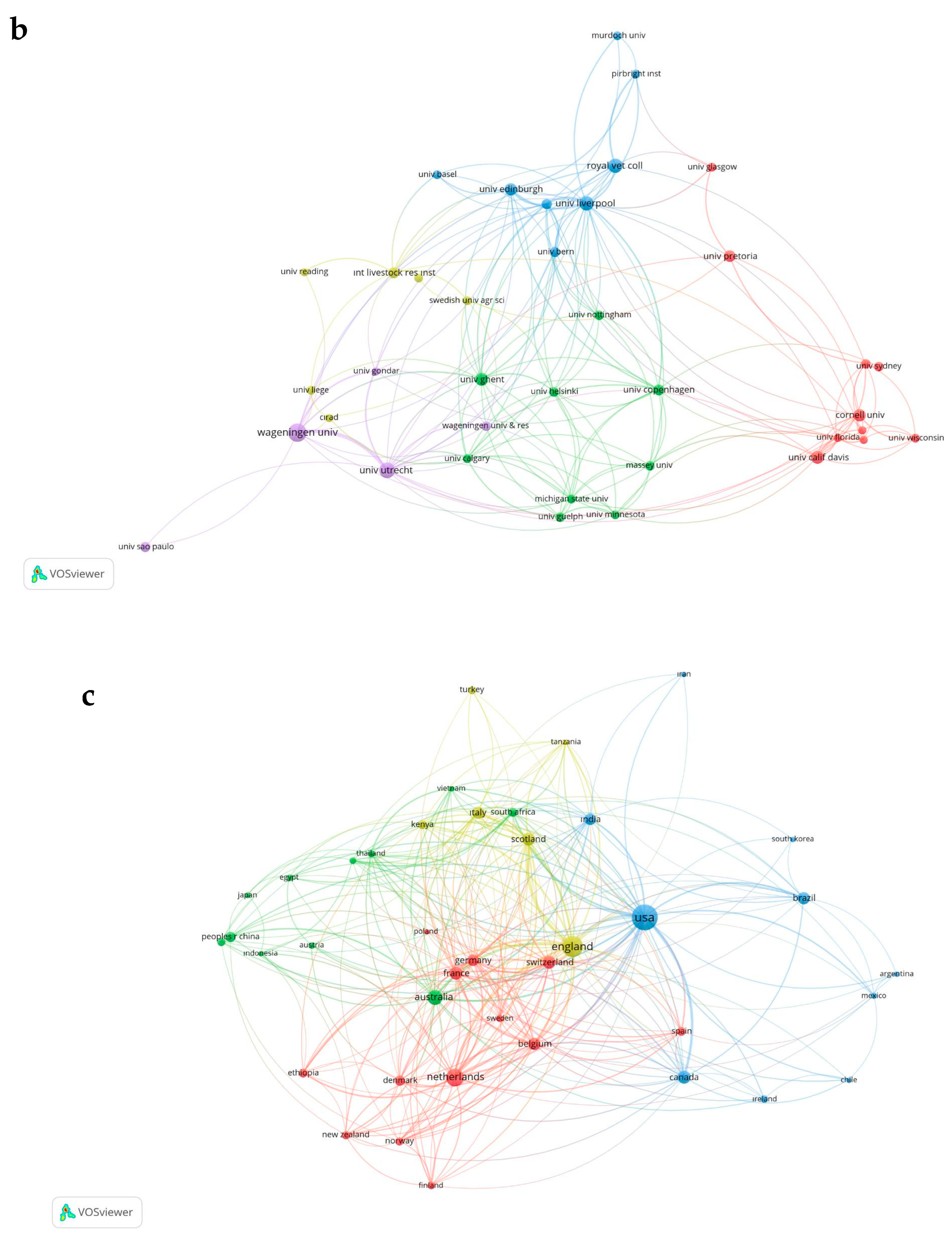
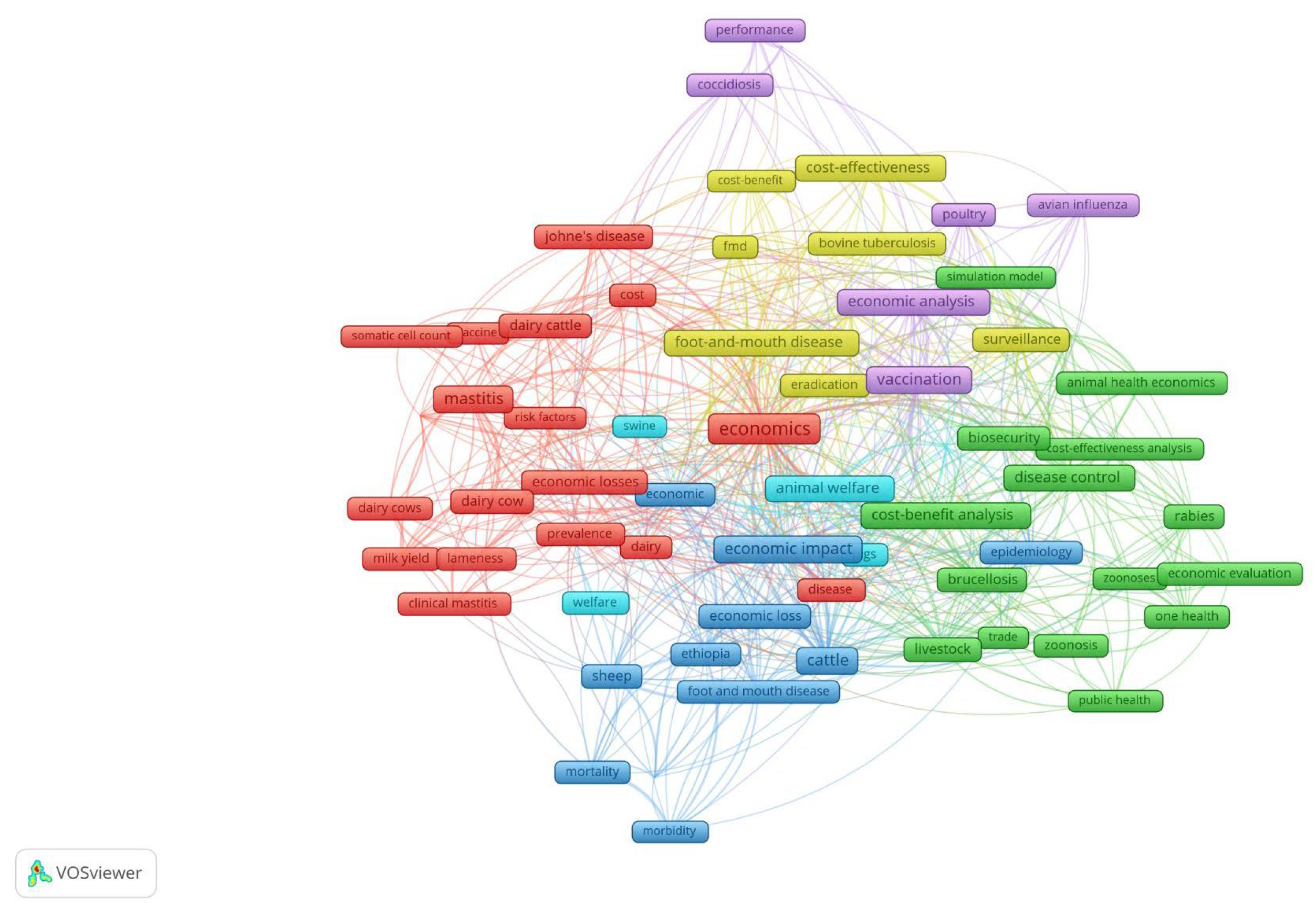

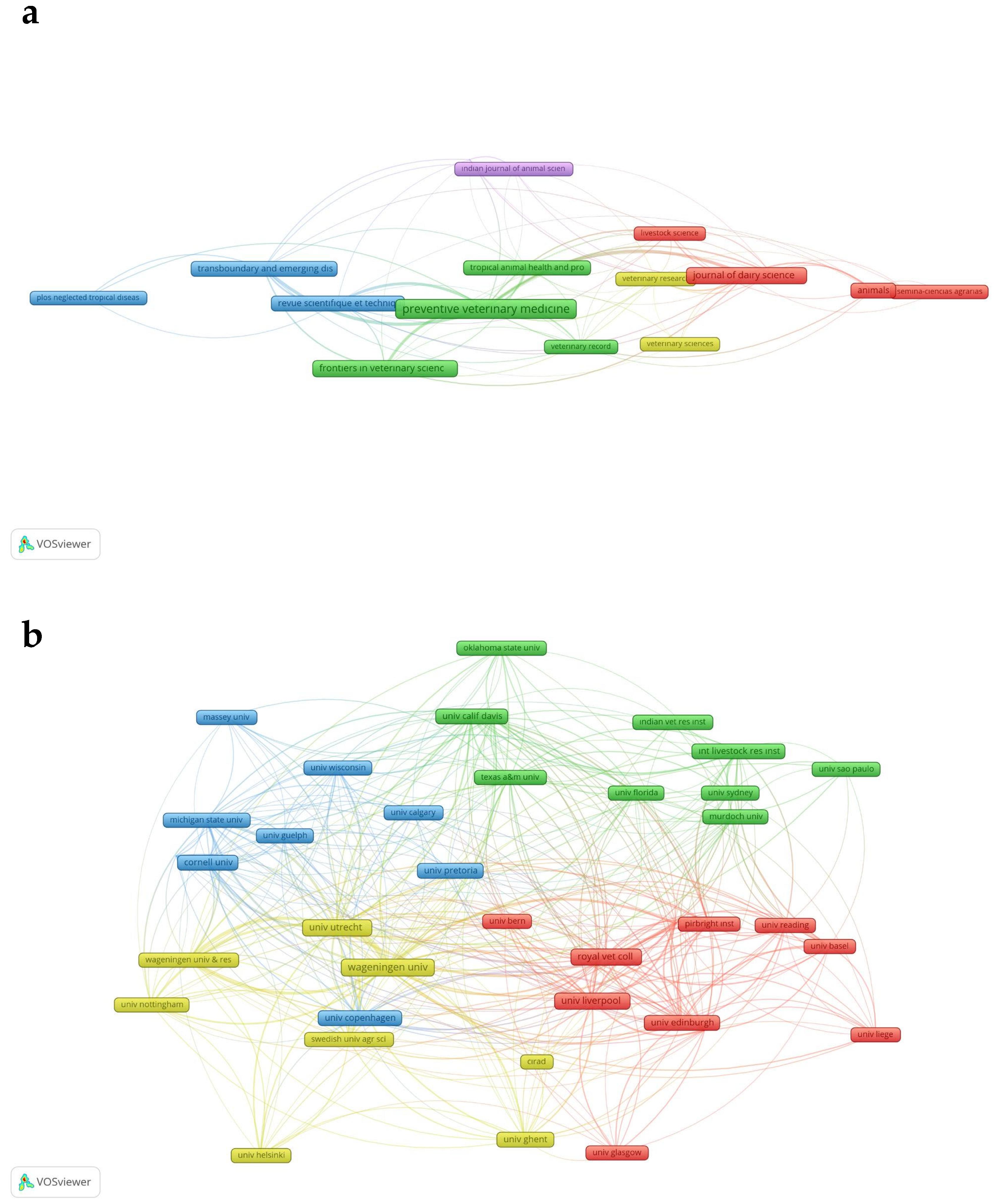
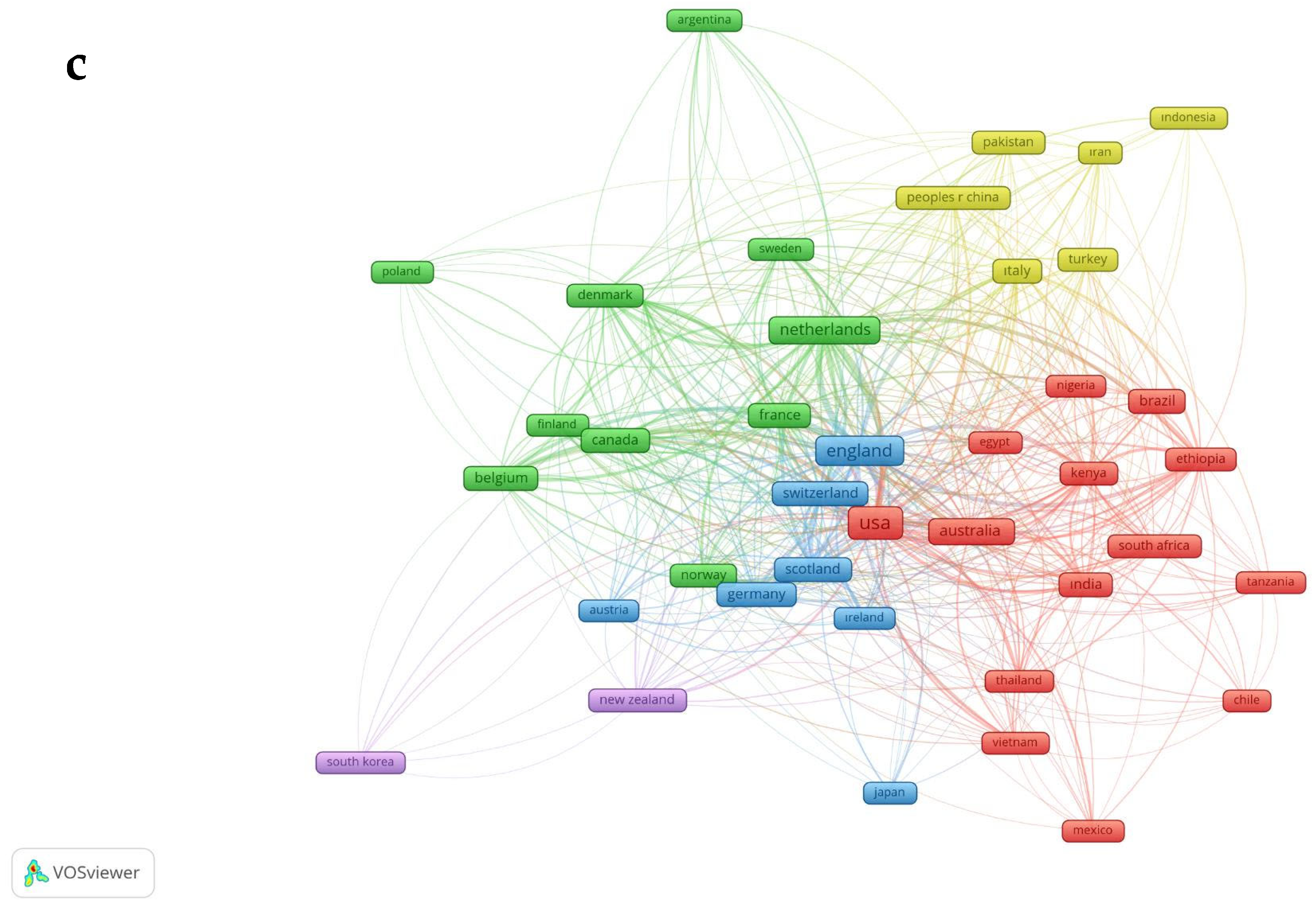
| Unit | All Citations | All Articles | h-Index |
|---|---|---|---|
| Hogeveen H | 2667 | 40 | 22 |
| Rushton J | 1742 | 37 | 17 |
| Häsler B | 335 | 17 | 10 |
| Rich KM | 354 | 13 | 10 |
| Stott AW | 334 | 12 | 9 |
| Halasa T | 1025 | 9 | 9 |
| Gunn GJ | 317 | 11 | 9 |
| Saatkamp HW | 329 | 17 | 9 |
| Torgerson PR | 528 | 10 | 9 |
| Zinsstag J | 1778 | 11 | 9 |
| References | No. of Citations |
|---|---|
| Rushton, J. (1999) [9] | 50 |
| McInerney, J. (1992) [10] | 50 |
| Knight-Jones, TJD. (2013) [3] | 44 |
| Seegers, H. (2003) [11] | 42 |
| Rushton, J. (2009) [1] | 40 |
| Halasa, T. (2007) [12] | 38 |
| Huijps, K. (2008) [13] | 36 |
| McInerney, J. (1996) [2] | 35 |
| Dijkhuizen, A. (1997) [14] | 31 |
| Bennett, R. (2003) [15] | 31 |
Disclaimer/Publisher’s Note: The statements, opinions and data contained in all publications are solely those of the individual author(s) and contributor(s) and not of MDPI and/or the editor(s). MDPI and/or the editor(s) disclaim responsibility for any injury to people or property resulting from any ideas, methods, instructions or products referred to in the content. |
© 2025 by the authors. Licensee MDPI, Basel, Switzerland. This article is an open access article distributed under the terms and conditions of the Creative Commons Attribution (CC BY) license (https://creativecommons.org/licenses/by/4.0/).
Share and Cite
Peker, A.; Orkan, Ş.; Magrin, L.; Segato, S. The Economics of Animal Health: A 25-Year Bibliometric Analysis. Animals 2025, 15, 3006. https://doi.org/10.3390/ani15203006
Peker A, Orkan Ş, Magrin L, Segato S. The Economics of Animal Health: A 25-Year Bibliometric Analysis. Animals. 2025; 15(20):3006. https://doi.org/10.3390/ani15203006
Chicago/Turabian StylePeker, Arzu, Şükrü Orkan, Luisa Magrin, and Severino Segato. 2025. "The Economics of Animal Health: A 25-Year Bibliometric Analysis" Animals 15, no. 20: 3006. https://doi.org/10.3390/ani15203006
APA StylePeker, A., Orkan, Ş., Magrin, L., & Segato, S. (2025). The Economics of Animal Health: A 25-Year Bibliometric Analysis. Animals, 15(20), 3006. https://doi.org/10.3390/ani15203006







